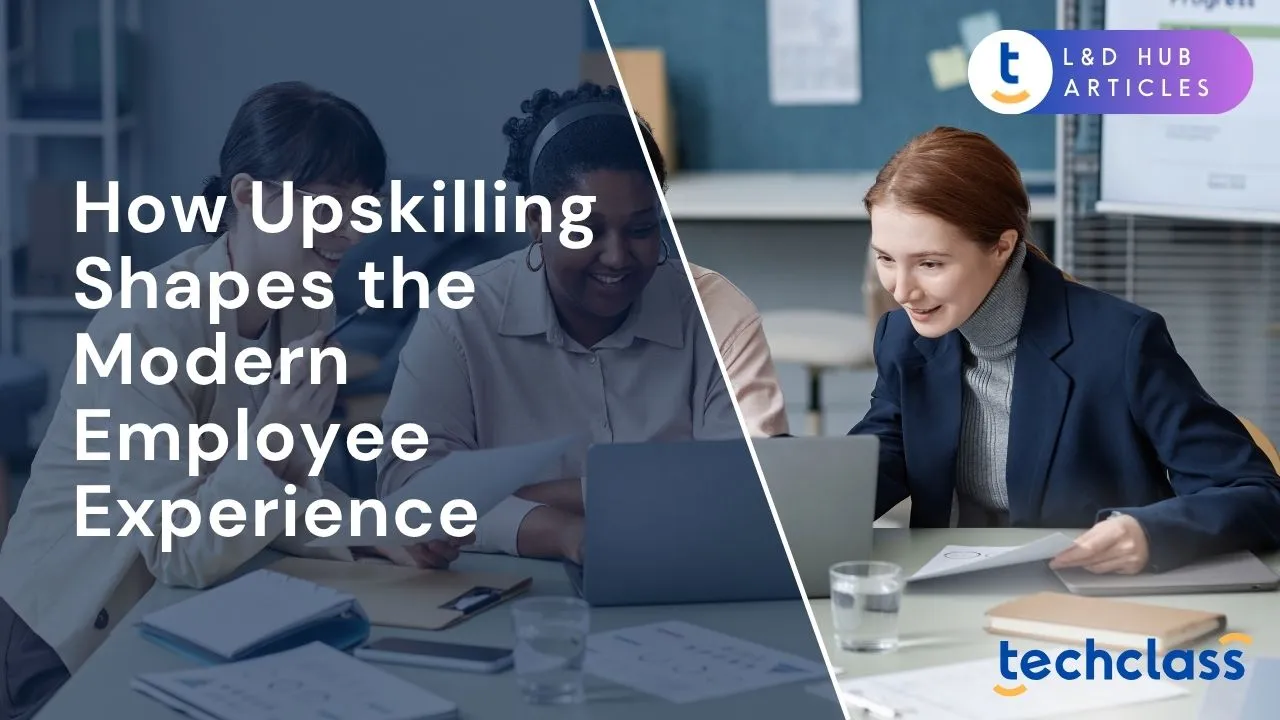
In a business landscape defined by rapid technological change, companies are facing an urgent need to continuously develop their employees’ skills. Advances such as artificial intelligence and automation are redefining job requirements at a swift pace. In fact, a majority of Fortune 500 Chief HR Officers anticipate AI will begin replacing some roles in the next few years. For organizations and their people, this means upskilling – the process of teaching employees new competencies – has become more critical than ever. Modern employees don’t just appreciate opportunities to learn; they expect them as part of a fulfilling career experience. When employees can acquire new skills and grow professionally within their roles, they feel more secure and supported amid change. On the other hand, a lack of development paths can leave workers anxious about falling behind. Upskilling is emerging as a key pillar of the employee experience because it empowers individuals to adapt to change, find purpose in their work, and envision a future with their employer. In the following sections, we’ll explore how a strong upskilling strategy can positively shape engagement, retention, and the overall workplace culture.
One of the most immediate ways upskilling enhances the employee experience is by improving day-to-day engagement. Employees who have chances to learn and develop tend to be more motivated, confident, and invested in their work. When people gain new skills, they often feel a sense of accomplishment and progress that can break the monotony of routine tasks. Surveys indicate that over half of workers feel they need more training to perform their jobs more effectively. Without growth opportunities, employees can become disengaged; they may feel their talents are stagnating or not fully utilized. By contrast, offering upskilling options shows employees that the company values their development, which boosts morale.
Importantly, continuous learning also taps into employees’ personal aspirations. Many workers view professional development as part of their own growth journey, not just a job requirement. In one study, 77% of employees agreed that learning new skills gives them a sense of purpose. Providing avenues for that personal growth, whether through workshops, online courses, or stretch assignments, helps individuals find meaning and satisfaction in their roles. They develop a growth mindset, approaching challenges as opportunities to learn rather than obstacles. This mindset not only increases engagement but also drives innovation, as employees feel encouraged to experiment and expand their abilities.
Upskilling can be especially impactful for younger generations in the workforce. Studies have found that Millennials and Gen Z employees rank learning and advancement opportunities among the most important factors in job satisfaction and career decisions. Nearly 6 in 10 Millennial workers, for example, say that the ability to learn and grow is extremely important when applying for a job, a higher share than previous generations. This demonstrates that the rising cohort of employees expects their employer to provide continuous development. If they don’t find those opportunities, they are likely to become disengaged or move on. On the flip side, when an organization feeds that desire to grow, it can tap into a wellspring of motivation. Employees who feel they are progressing in their careers tend to exhibit higher engagement, loyalty, and enthusiasm in their daily work. They are more likely to go the extra mile, apply new ideas, and contribute positively to the workplace culture. In short, upskilling fuels employee engagement by aligning work with personal development goals – creating a workplace where learning is part of the experience and employees feel energized to bring their best selves to the job every day.
Beyond day-to-day morale, upskilling has profound effects on whether employees choose to stay with a company. In today’s competitive talent market, offering robust development opportunities is one of the most effective strategies for employee retention. Multiple surveys have shown a clear trend: employees are significantly more likely to remain at a company if they feel that it invests in their growth. One landmark finding by LinkedIn indicated that 94% of employees would stay at a company longer if it simply helped them learn and advance in their careers. In another survey, over three-quarters of workers (76%) said they’d be more inclined to stay with an employer that offers continuous training and upskilling programs. These statistics underscore an important point – lack of development is often a driving factor in turnover, whereas ample learning opportunities foster loyalty. When people see a path to advance internally, they don’t need to look elsewhere for career growth.
Employers are taking note. Major companies have launched ambitious upskilling initiatives as a strategy to retain talent and fill future skill needs from within. For example, Amazon pledged to spend $700 million to train 100,000 of its employees in new skills by 2025. This “Upskilling 2025” program provides workers with training pathways into higher-skilled roles, ranging from software engineering to cloud computing. The logic behind such investments is clear: if employees can envision a future at the company – moving into new positions rather than hitting a dead-end – they are far more likely to stay. In Amazon’s case, some participants have already credited the upskilling programs with helping them gain promotions and relaunch their careers within the organization. By creating these internal career mobility options, companies not only hold on to valued employees but also save on the high costs of turnover and recruiting outside talent. A culture of promoting from within, enabled by training, breeds loyalty. Workers see that dedication is rewarded with growth, which strengthens their commitment to the organization.
Upskilling doesn’t just keep current staff on board – it also serves as a powerful talent attraction tool. Employers known for developing their people have a competitive edge in recruiting, because today’s job seekers actively seek out roles where they can continue learning. In a joint study by the Society for Human Resource Management (SHRM) and TalentLMS, 83% of HR managers reported that offering training is beneficial in attracting new talent. Nearly half of employees surveyed (48%) said that the availability of professional development opportunities was a factor in choosing their current company. Prospective hires, especially those early in their careers, are drawn to organizations that will invest in their future. They want to know, “Will I be able to grow here?” If the answer is yes – through mentorship programs, skill workshops, tuition support, and so on – then a company instantly becomes more appealing. In contrast, organizations that neglect employee development may struggle to lure high-potential candidates who are looking for more than just a paycheck.
In essence, upskilling shapes the modern employee experience by building a win-win scenario: employees gain career advancement and feel valued, while employers benefit from higher retention rates and a stronger talent pipeline. HR leaders overwhelmingly recognize this dynamic. In the same SHRM survey, 86% of HR managers said that training and upskilling help improve employee retention. They understand that when people see a future with their company, they are far less likely to leave. Research by Gallup reinforces this – employees who strongly agree that their employer encourages them to learn new skills are 47% less likely to be actively job hunting. By prioritizing development, companies create a loyal workforce and also boost their reputation in the job market as a place where professionals can grow. This reputation can become a magnet for talent. In summary, making upskilling a core part of the employee experience helps organizations keep their best people and attract quality new hires, fueling a cycle of growth for both employees and the business.
To fully reap the benefits of upskilling, companies must embed it into their culture. It’s not enough to offer a few training sessions; the goal is to create a continuous learning culture where development is an ongoing, integrated aspect of work life. From the HR perspective, this cultural shift is now seen as crucial. Recent research revealed that reinforcing the employee experience is a leading training goal for over 90% of HR managers, highlighting that learning and development (L&D) is viewed as a key driver of a positive, engaging workplace culture. In practical terms, building such a culture starts with leadership. Leaders and managers should actively champion upskilling – by communicating the importance of learning, giving employees time and resources to pursue development, and even participating in training themselves. When employees see their leaders prioritize growth, it sends a powerful message that “learning is part of how we do things here.”
Another element of a learning culture is recognition and encouragement. Organizations that celebrate employees for developing new skills set a strong precedent. For example, if a team member completes a certification or learns a new tool, acknowledging that achievement (through shout-outs, rewards, or new opportunities) reinforces the desired behavior. Employees then understand that growing their skills is not only supported but also appreciated. According to a Gallup-Workhuman study, when employees feel that learning is recognized in their workplace, they are significantly more likely to be motivated to pursue more training. Even simple forms of recognition can boost participation in upskilling and signal that the company truly cares about employee growth.
Companies should also strive to make learning accessible, relevant, and personalized. Busy professionals may shy away from development if it feels too time-consuming or disconnected from their goals. HR can address this by providing a variety of learning formats – such as on-demand e-learning modules, micro-learning snippets, workshops during work hours, and peer-to-peer learning sessions – to fit different schedules and learning styles. It’s also important to tailor upskilling programs to align with employees’ roles and career aspirations. Many employees want training that is directly relevant to their current job or next career step. For instance, an engineer might want to learn a new programming language that’s growing in the industry, or a salesperson might seek training in advanced negotiation skills. Employers can use surveys, career development plans, and coaching conversations to pinpoint what skills are most meaningful to their staff. By involving employees in choosing their development paths, companies ensure higher engagement in the training itself and better outcomes.
Fostering a continuous learning culture additionally means integrating learning into the flow of work. This could involve setting aside regular time for skill development, like a few hours a month dedicated to learning, or incorporating stretch assignments that allow employees to develop new competencies on the job. Some organizations establish “lunch and learn” sessions or internal knowledge-sharing forums so that learning becomes a social, routine part of the workweek rather than a rare event. Technology can support this integration as well. Modern learning platforms and apps can deliver bite-sized lessons or tips as part of daily workflows, making it easy for employees to pick up knowledge during natural breaks. The easier and more embedded the learning process is, the more likely employees will engage with it consistently.
Finally, building a learning culture is about creating an environment of safety and support for learning. Employees should feel safe to admit what they don’t know and take on the challenge of acquiring new skills. That requires a mindset shift in some workplaces, from expecting employees to already have all the answers to encouraging curiosity and continuous improvement. Managers play a key role by giving constructive feedback and framing skill gaps as opportunities for development rather than deficiencies. When done right, the result is a workforce that is adaptable and resilient. As new technologies or market changes arise, employees in a learning culture respond with agility: they have the habit of learning, so they approach change with confidence instead of fear. This adaptability is hugely beneficial to companies navigating fast-changing industries. In summary, making upskilling part of the company DNA, through leadership support, recognition, tailored opportunities, and integrated learning, transforms the employee experience. It creates a positive feedback loop where employees feel empowered to grow, which in turn drives innovation, engagement, and company success.
Upskilling is no longer an optional perk or a one-time intervention – it has become a foundational pillar of the modern employee experience. In an era where change is the only constant, the ability for employees to continually learn and evolve determines not just their personal career success but also the success of the organization as a whole. Companies that embrace upskilling signal to their workforce: “We are invested in your future.” This message resonates profoundly with employees. It leads to higher morale, as people feel valued and equipped to meet new challenges. It leads to stronger loyalty, as individuals see a long-term path with their employer. And it creates a more vibrant, future-ready business, as skill gaps close and innovation accelerates.
For HR professionals and business leaders, prioritizing upskilling is an educational and strategic move. By weaving continuous learning into every stage of the employee journey – from onboarding, through career development, and even into leadership training – organizations build a culture that attracts talent and retains expertise. Every training session, mentorship program, or new skill learned contributes to a workplace environment where growth is the norm. Employees come to work not just to do a job, but to better themselves, collaborate on new ideas, and push the company forward. This kind of engaged, empowered workforce is better prepared to adapt to industry disruptions and seize new opportunities.
In closing, the companies that will thrive in the years ahead are those that see employee development as a strategic imperative. Upskilling shapes how employees experience their work by making it dynamic, meaningful, and aligned with their personal growth. It turns the workplace into a place of continuous improvement rather than static routine. As the data shows, when people grow, they stay – and they give their best. By making upskilling a central pillar of the employee experience, organizations can build not only a more skilled workforce, but also a more committed, innovative, and happy one. Investing in your employees’ growth is ultimately an investment in the growth of your business. In a modern economy, that’s a formula for success for everyone involved.
Upskilling helps employees adapt to rapid technological changes, boosts engagement, improves retention, and fosters a culture of continuous learning.
It increases motivation, confidence, and a sense of purpose by providing growth opportunities, making work more meaningful and inspiring innovation.
Leaders should actively promote upskilling, communicate its importance, participate in training, and recognize employees’ skill development efforts.
Offering development opportunities makes companies more attractive to potential hires and encourages current employees to stay by providing internal growth paths.
Providing personalized learning options, integrating learning into daily routines, recognizing achievements, and creating a safe environment for growth.


